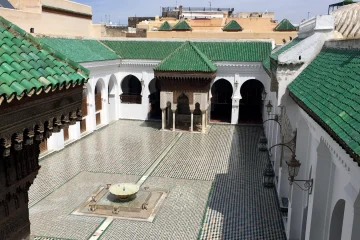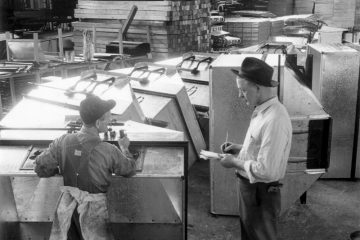While Hogwarts might be a figment of our fantastical imaginations, education in the conjuring arts has a very long and very real history, so I guess it is not a surprise that there are libraries for that! As I delved deeper into the conjuring arts, I was amazed not only at the libraries featuring magic, but also some loan out equipment including magic props, provide seminars, and even offer conjuring arts video. I also discovered an entire online database that is devoted to magic. The two main conjuring arts libraries I discovered include David Copperfield’s private International Museum and Library of the Conjuring Arts, in Las Vegas, Nevada and The Conjuring Arts Research Center in New York, New York. However, there are several smaller magic related libraries and magic collections in larger institutions.
History
Magic or conjuring has a long history, and this history has been recorded in written form at least since the 15th century. Historically, libraries of the conjuring arts have been largely private, and in many cases, secret. The collections were closely guarded, the magic concealed in the books for a lucky few only. It wouldn’t do, some believed, for everyone to have access to magician’s secrets. So, the 2011 opening of The Conjuring Arts Research Center and its database has filled a real gap. Founded by Bill Kalush after collecting magic memorabilia for decades, the library was established in 2003. One of the oldest documents in the collection dates to 1476: a page from printer William Caxton’s Canterbury Tales that references a magician. Copperfield started his museum and library in 1991 after the purchase of a large collection of the Mulholland Library with more than 80,000 items. It holds a first edition of Reginald Scot’s The Discoverie of Witchcraft published in 1584.
Where do they work?
Full-fledged conjuring libraries are few and far between though there are at least 24 museums devoted to magic, several of them with internal libraries. The largest magic museum in the United States is the American Museum of Magic in Marshall, Michigan, and it also includes a research library. The Conjuring Arts Research Library in New York has more than 15,000 books, manuscripts, and letters in addition to a variety of props and magic tools. It is open to the public by appointment. Overseeing this collection are a staff of six plus interns and volunteers. Copperfield’s collection is huge with everything from books to costumes, posters, and props. Special librarians might also work at smaller collections like the public W.G. Alma Conjuring Collection at the State Library in Victoria, Australia and the private H. Adrian Smith Collection of Conjuring and Magicana.
What do they do?
While these collections predominantly feature books, several include equipment, tools, wands and magic trick paraphernalia. The Conjuring Arts Research Center staff is working on digitizing the collection, including digitizing magicians’ personal papers, and on developing the library’s database, Ask Alexander. The library is committed to preserving the collection over time. Employees also engage in transcription of letters and digitizing of video. Librarians interested in focusing on magic might also work with special collections that feature magic and conjuring materials (see brief list at the end of this post). Other libraries, like the WG Alma Conjuring Collection, are continually working on collection development and offer a pretty extensive library guide for the public. The H. Adrian Smith Collection is in the process of moving their materials online. And, perhaps, a special librarian might be busy making finding aids, like the Carl W. Jones Magic Collection at Princeton University. At the Newcastle University Library, the focus is on herbal magic.
What tools will be helpful?
While the ability to do magic tricks is not required, patience (there are only a few of these jobs out there after all) and perhaps some knowledge of the occult, psychic phenomena, and conjuring would be helpful. This bibliography would be a great resource for a conjuring librarian!
Why a conjuring library?
Who doesn’t like to venture, occasionally, into fantasy and the otherworldly? Those with a passion for magic from the cozy to the sinister will find a job in one of these libraries particularly exciting.
Who do they serve?
This may be an intriguing question for this type of library. After all, despite the popularity of wizards and witches that Harry Potter awoke, there are simply not a bunch of wizards and witches flocking to these libraries. The users at the W.G. Alma Collection are a mix of historians, writers, and those with a passion for magic and the related arts. Also, those writing books or making movies with magic as a component are frequent users of these libraries.
What are the differences?
What makes working in a conjuring library special besides the collection? These libraries tend to cater to specialists, including those with a career in magic, which makes for an interesting (and often talented) user, but they also are visited by filmmakers and writers seeking to add credibility to their creative works. Most collections are small, and special librarians might find themselves overseeing “the performing arts collection,” like the one at University of California at Santa Barbara, or the rare books collection that includes magic materials like the Vail collection at Massachusetts Institute of Technology, which features magnetism, occultism, spiritualism, and psychic phenomena.
Want to learn more about this special library opportunity?
Check out one of these sources:
Harry Houdini Special Collection at the Library of Congress
Magic and Conjuring Collection at Ohio State University
British Manuals and Guides to Magic Tricks Collection at UC Santa Barbara
McManus-Young Collection at University of Texas
Damon Collection of Occult and Visionary Literature
Tour Copperfield’s museum with Oprah Winfrey




1 Comment
Kaylynn Clark · 16 Aug 2017 at 7:36 AM
This is a really fun topic!